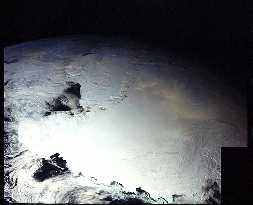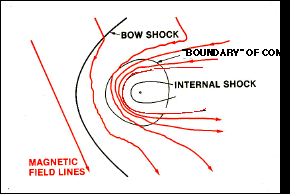This picture shows Pluto (left) and its big moon Charon (right). This picture was taken by the Hubble Space Telescope in 1994.
Click on image for full size
Image courtesy Dr. R. Albrecht (ESA/ESO Space Telescope European Coordinating Facility) and NASA.
Charon - Pluto's biggest moon
Charon is a moon of Pluto. Pluto has
moons. Charon is much bigger than
Pluto's other moons. James Christy discovered
Charon in 1978.
Charon is nearly as big as Pluto. Some astronomers call Pluto and Charon a "double
planet". Charon is also very close to Pluto. Because Charon is so
close, it goes around Pluto fast. It only takes Charon about
six days to orbit Pluto. It takes our Moon a month to go around Earth!
Did you know that we can only see one side of our Moon from Earth?
That's because the Moon spins around in
exactly the same amount of time it takes it to orbit Earth. The same
thing is true for Charon and Pluto. Someone on Pluto could only ever see one
side
of Charon. Now here's the really strange part. Pluto also spins exactly as
fast as Charon. So if you were on one side of Pluto, Charon would always be
up in the sky. If you were on the other side of Pluto, you would never see
Charon at all!
Charon is made of rock and ice,
like Pluto. Some astronomers think Charon formed when a large object
crashed into Pluto. That is a lot like how scientists think Earth's
moon formed. Other scientists aren't quite so sure that Charon was formed
that way.
Charon is named after a character from Greek
mythology. Charon was the ferryman of the dead. He took people who had
just died across a river in a boat. He took them to Hades, the underworld. Hades was
also the name of the god of the underworld. In Roman mythology, Hades
was called Pluto.
You might also be interested in:

Pluto is a frigid ball of ice and rock that orbits far from the Sun on the frozen fringes of our Solar System. Considered a planet, though a rather odd one, from its discovery in 1930 until 2006, it was
...more
Pluto has // Call the moon count function defined in the document head print_moon_count('pluto'); moons. One of the moons is very big. The big moon is name Charon. The other two moons are small. They don't
...more
Of all the planets and moons in the solar system, Pluto and Charon are the two which are the most alike. They are almost the same size, and they are very close together. Pluto and Charon are so close
...more
Pluto is so far away, and has never been explored. Questions to answer about Pluto include the following: What are the geologic features of the surface? (pictures of the surface) If there are bare spots,
...more
It may seem hard to believe that Pluto could have an atmosphere because it is so cold, but it does. Because there are times when Pluto is closer to the sun than is Neptune (making it the 8th planet for
...more
No one knows whether or not Pluto has a magnetosphere. Scientists were very surprised to find that Jupiter's icy moon Ganymede had a magnetosphere because it is hard to explain how an icy body can develop
...more
The diagram to the left shows what the inside of Pluto may look like. Pluto is mostly made of ice, with a small core of some rocky material buried inside. If the interior is warm enough, the inside of
...more













